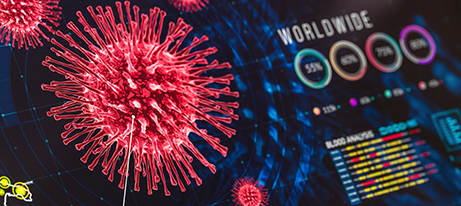
Getty Images /sankai
A technology innovation contest held by the U.S. Department of Health and Human Services (HHS) aims to bring COVID-19 diagnostic tests to market with built-in, automated, harmonized data capture and wireless transmission capabilities. On December 16, HHS chose 16 winners from a pool of 31 applicants who will advance their technologies for commercial use in 2021.
The COVID-19 At-Anywhere Diagnostics Design-a-thon “harnessed the power of American ingenuity to ensure we have accurate, user-friendly reporting of COVID-19 testing results, especially those from rapid, easy to use tests,” said Assistant Secretary for Health Admiral Brett P. Giroir, MD, in a statement. Utilization of rapid diagnostics such as point-of-care, over-the-counter, and at-home tests is on the rise. However, these tests “often lack an easy way for users, such as schools, nursing homes, or businesses, to report results. This effort will address this gap,” said Giroir.
HHS received 31 final capstone project submissions among a pool of 363 registered participants. A panel of 16 public and private subject matter experts judged the final entries.
4 technologies won the top awards:
Gold: Oracle: COVID-19 Immutable Test Results Submission and Visualization A front-end Web application and representational state transfer application programs interfaces to help submit test results directly from mobile apps, test manufacturers, or administrator networks. Uses a suite of technologies to enable real-time reporting of and tracking of individual and batched results.
Silver (tie):
Interpret-COVID: Consumer Dx Test App An application that disseminates Covid Dx test information authorized by the Food and Drug Administration to consumers and uses blockchain to collect outcome data for post-market analysis. According to the developer, the system will not collect or track personally identifiable data. The app allows consumers to collect, track or share test results with their doctors or provide anonymous input on tests and clinical outcomes.
Oasys: One Country, One Data Standard, One Process for all Smartphone technology makes it easier for patients to input data. It interfaces with Gov-Cloud and uses near Real-Time Data Streaming technology to instantly refine, enrich, aggregate and report data. Artificial intelligence technology allows patients in remote areas to register over a landline.
Bronze: Net Medical Xpress Solutions, Inc: Net Medical's Telemed for COVID-19 Wireless Data This approach uses questionnaires, order, and diagnostic forms to support COVID-19 data collection and harmonization.
11 additional technologies received Honorable Mention awards:
One of the Honorable Mention winners, the NYU: Smart Diagnostics Ecosystem for COVID-19 Disease Management, also won the contest’s People’s Choice award. DLC-Delta: Co-Verify Solution won the People’s Choice runner-up category.
The Design-a-thon launched on November 9. This virtual technology “sprint” aimed to bring public and private sector innovators together to develop software and digital health tools that integrate with in vitro diagnostics (IVDs) to achieve two primary goals:
- Align software developers, designers, and engineers with IVD device developers and COVID-19 subject matter experts to build software and digital tools that directly integrate with COVID-19 tests.
- Build the infrastructure to enable flexible, extensible, automated, harmonized, device-agnostic diagnostic data reporting directly between HHS Protect and various reporting systems, called Wireless Automated Transmission for Electronic Reporting Systems.
This would result in simultaneous “packaging” and pushing of different datasets to different public health authorities. Such capabilities “will alleviate data collection and reporting burdens for patients, providers, anyone administering/using tests, and labs through which data is routed,” an HHS spokesperson told CLN Stat. “Perhaps most critically, these capabilities will be absolutely necessary (for data capture and reporting) when fully at-home, nonprescription, and over-the-counter tests are authorized and begin saturating the market,” the spokesperson added.
Winners of the Design-a-thon will advance to a 4- to 6-week TOPx (The Opportunity Project) virtual tech sprint to expedite product development and commercialization. The culmination of TOPx is a public-facing “Demo Day” rollout, which will showcase many potential solutions and products from many different organizations, including government apps and tools.
“At this time, only selected winners will be invited to the TOPx phase. However, it is possible that the next phase of development could be open to others based on feedback and insights from the Design-a-thon,” said the HHS spokesperson.
All Design-a-thon participants will eventually have the opportunity to test mock data submissions via the WATERS interface, working directly with HHS to further develop this public tool. “Further development of the WATERS interface will continue into 2021, running in parallel with TOPx, and the entire community is welcome to engage in this process regardless of their formal involvement in the tech sprint,” said the spokesperson.